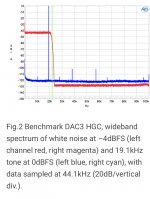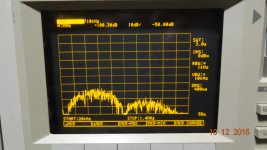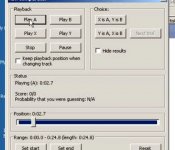Typical measured levels above 22Khz are -60dbv. I had not checked a DAC lately... only out of CD/DVD players awhile back. But, I measured a new streaming DAC. Just put out on the market and the noise/HF level was -60dbv average. Designer said it used the filter in the DAC chip and no other. But, that does not drive a speaker - it goes to line level/preamp source selector for 20db gain maybe. And, another 30db gain in power amp. So, level is much higher than DAC to PA and to SPKR/Tweeter.
Needs to be IMHO below .01% thd out of DAC.
THx-RNMarsh
Attachments
Jumping a little too fast to conclusions ?
I dont care of the papers of one or another, I trust my ears, taking great care of Group delay in speakers since decades and I can assure-you it makes a difference.
One thing you can verify by yourself, comparing a digital equaliser with an analog equivalent. Reason why so many sound engineers continue to use big analog mixing desks for music.
Please describe your GD evaluation setup where you could change/control GD and only GD and nothing else.
//
It gets wilder and wilder.
What will be the next BS ?
Hans
Yes, that is a little to rich... no?
//
... I was more wondering if those articles I linked are sufficiently true to use for educational reference?
There was a link to an article at: Is Linear Phase
Really Ideal for Audio? | Introduction to Digital Filters
...It looks like a good site for explaining about DSP, if that is your interest.
Other than that, this is probably not the best place for me to explain to you about things that you may hear. Some of the guys find it annoying. And now they will probably tell you why, as if you don't already know.
Last edited:
So your DAC design criteria is "clean the DAC until the default filter sounds good".
And some were wondering what will be the next BS. But because you added the YMMV you are excused this time.
A linear phase filter is PCM theorem kosher. So this I think makes some sense really.
//
Mark,
I was more wondering if those articles I linked are sufficiently true to use for educational reference? I’m finding it hard to differentiate if what comes across as fact actually is......in other words sorting bs from fact when trying to educate myself. Pretty sure I’m not the only one wishing to learn but finding clear reference material difficult.
It's difficult to sort out the incorrect information when trying to learn something new.
Basically the information from audioholics that you've linked is correct; there some quirks/errors, but at a first glance nothing too bad wrt to the technical side.
Generally rasing the rate in the digital domain is denoted as "upsampling" and lowering the rate is denoted as "downsampling".
Historically however in the audio field, there is often the term "oversampling" used when in the digital domain the rate is raised by an even factor (like 2x , 4x, 8x and so on) and the term "upsampling" is used if the raising factor is a fraction number.
In theory it wouldn't matter if this sampling rate conversion is done in a cd-player (for example) or external DAC or prior by a computer. But it often was better to do it not in real time by using a computer, where it could be done as precise as possible (due to higher processing power) or offline without the need to do it in real time, just for later reply.
As usual the controversy starts when it comes to the audibility of any conversion process; and the verdict might be very different when assessing gear from the various decades, but up to now it is still possible that some D/A integrated circuits work better when having not to do any "upsampling" or even when only kind of feed through of a DSD-signal.
Btw, dsprelated.com is a good resource; if you're interested in the mathematical foundations, look for free books by Julius O.Smith or his webpage.
Edit: Sorry the linked webpage is already from one of Smith's books.....
Last edited:
A linear phase filter is PCM theorem kosher. So this I think makes some sense really.
Of course - what I find uber funny is the design process, which assumes you can get along with another filter until you get the rest right ("clean").
@Billshurv & Hans Polak,
How on earth can that be read as "accusing" someone as cheating?
If someone is willing to accept any ABX protocol as sufficient evidence, he should be aware that Foobar-ABX can be cheated. If the reason for demanding Foorbar-ABX results/reports is the "hash number anti cheat provision" then it is important, isn't it?
It gets wilder and wilder.
What will be the next BS ?
Hans
How on earth can that be read as "accusing" someone as cheating?
If someone is willing to accept any ABX protocol as sufficient evidence, he should be aware that Foobar-ABX can be cheated. If the reason for demanding Foorbar-ABX results/reports is the "hash number anti cheat provision" then it is important, isn't it?
I should have said THD plus Noise was wide band measured to be -60 dBv... needs to be less than .01% THD+N or more than -80 after filter.
eg Not FFT measured.
Should also mention measured with digital out of a CD player playing into external DAC and then out of DAC analog to wideband rms meter and filtered with HPF. Basically, the same numbers when using spectrum analyzer above 22Khz.
How to atten this HF to-80 and more and not affect the <22Khz in any way. Shown is one of the better ones. But the gains afterwards leaves us with a 30-50dB worse level after further amplification in the music repo system.
How can this be improved by a needed 30-dB or more without further affecting GD and phase issues <20KHz??
-RNM
eg Not FFT measured.
Should also mention measured with digital out of a CD player playing into external DAC and then out of DAC analog to wideband rms meter and filtered with HPF. Basically, the same numbers when using spectrum analyzer above 22Khz.
How to atten this HF to-80 and more and not affect the <22Khz in any way. Shown is one of the better ones. But the gains afterwards leaves us with a 30-50dB worse level after further amplification in the music repo system.
How can this be improved by a needed 30-dB or more without further affecting GD and phase issues <20KHz??
-RNM
Attachments
Last edited:
Well only one ABX result was posted for that test...@Billshurv & Hans Polak,
How on earth can that be read as "accusing" someone as cheating?
?
...which assumes you can get along with another filter until you get the rest right...
Not an assumption really. Rather, an observation of expressed subjective preference. For example, one could see it happening as forum members improved the various power supplies needed for Allo Katana dac. Even the designer of the dac changed his filter preference as the dac design evolved (it was cleaned up, in lay terms). Other examples exist too. Again, not an assumption.
Last edited:
Thanks fellers,
So this pre-ringing chirp I’ve heard is getting into zero phase and then when dialed back with dsp until it just about disappears (what I consider the ‘sweet spot’ of my system) is going towards minimum phase, masking it backwards instead of forwards......which apparently is the lesser of the evils as to perception?
So this pre-ringing chirp I’ve heard is getting into zero phase and then when dialed back with dsp until it just about disappears (what I consider the ‘sweet spot’ of my system) is going towards minimum phase, masking it backwards instead of forwards......which apparently is the lesser of the evils as to perception?
Last edited:
must be accelerated to several thousand Gs.
Accelerating to G's does not make sense. Hiten for one posted contrary evidence by, I assume, someone who does not have something to sell. If you have an impartial study with real numbers by recognized material scientists I would gladly read it.
Doing an ABX on foobar I assume it's ok initially do a few forth and back clicks between "Play A" and "Play B" in order to familiarize with the tracks, but once starting the ABX test session strictly I thought one should use "Play X" and "Play Y" buttons only, and preferably also tick the "Hide results" box, that should be enough to not being able to fool the ABX test, anything else would be dishonest to the ABX test.
ABX Audio Testing with foobar2000 - Youtube
ABX Audio Testing with foobar2000 - Youtube
Attachments
Other than that, this is probably not the best place for me to explain to you about things that you may hear. Some of the guys find it annoying. And now they will probably tell you why, as if you don't already know.
If it has the potential to shed some light on correlation between measurement and perception there shouldn't be a problem
Interesting terminology. 😉I doubt PMA has 20-20 hearing.
What on earth are you talking about?As you are not following this rule it is quite strange that you demand it from others.
I demanded evidence for some of your bogus claims, you wriggled for an answer over weeks and at the end your "evidence" was pure gossip/imaginations from another forum, quite the opposite of "real facts" .

<snip>The level of confidence required to accept a certain outcome as proof is open to discussion and should always be made explicit.
That's why I asked. 🙂
me, when Pavel scores a consistent 9 out of 10 on a certain auditory stimulus, I am happy to accept that as sufficient proof that something is going on.
Now you have traded the "consistent" in, so I must ask how many replications are needed to be consistent and if the SL criterion may vary, as P(X=9 l 10)=0.011 for one 9/10 for two 9/10s it is P(X=18 l 20) = 0.0002 .
When it comes to opamp sound, you may accept a lower level of confidence, or a higher one, all basically a matter of taste. What do you think is good enough to be convinced?
I was just wondering as the traditional line of reasoning represents kind of the classic black box approach; not matter what's inside of the box, only important are the measured numbers wrt the known thresholds of hearing (provided that the system in the box is of the LTI kind).
Now it seems that we need different sets for different types of systems under evaluation; in this case it would a set for preamplifiers and another set for opamps (being maybe the main part of the preamplifiers) but is there any justification for this?
Everybody may decide for themselves.
Of course, Fisher himself already was adamant that no real scientist would use the same criterion for everything, but which to choose is obviously subjective.
Basically it is important to remember that we all have the tendency to fool ourselves and that we should avoid it; unfortunately fooling yourself is as simple with usage of "blind tests" as it is when using "sighted" listening and if one knows about it chances are IMO already higher to get something useful.
After all, in the field on audio development, the outcome of such tests may deliver actionable information. Do people prefer this tweeter over that one, is it worth the extra expense, etc. For a very small difference, you might wish to lower the bar because there is always noise.
But these questions are even more difficult to assess.
Last edited:
Thank you. What should the THD+N be in the amplifier, we don't need a preamp?I should have said THD plus Noise was wide band measured to be -60 dBv... needs to be less than .01% THD+N or more than -80 after filter.
“Is it worth the extra expense?”
Frugality seems to be top priority for many? I don’t quite understand that.....when I want premium results I buy premium parts.
I’m not talking going overboard with snake oil bs, I mean just use the best quality available parts for the job (‘good enough’ is a cop out imo)....going the extra mile doesn’t seem to be generally accepted?
Frugality seems to be top priority for many? I don’t quite understand that.....when I want premium results I buy premium parts.
I’m not talking going overboard with snake oil bs, I mean just use the best quality available parts for the job (‘good enough’ is a cop out imo)....going the extra mile doesn’t seem to be generally accepted?
Well only one ABX result was posted for that test...
Vacuphile wrote explicitely about what PMA would accept (as sufficient evidence) and in this context ....
@Ultima Thule,
could be a misunderstanding as the listener is forced to answer the question if "X" is "A" or "B" , so it wouldn't help to switch only between "X" and "Y" (because "X" and "Y" are still "A" and "B").
The original ABX sequence is indeed: listen to "A" then listen to "B" and then listen to "X" and finally make the decision if "X" = "A" or if "X" = "B"
Re-listening does not do harm as long as the sequence ABX is used.
Anything else wouldn't be an ABX-test anymore (by definition as the "ABX" denotes exact one specific kind of test) but just the usage of the "Foobar ABX tool" for doing a different test.
- Status
- Not open for further replies.
- Home
- Member Areas
- The Lounge
- John Curl's Blowtorch preamplifier part IV


